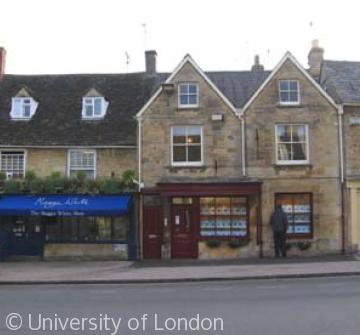High Street (east): Nos 47-49

The double-gabled smooth stone frontage of c.1903 conceals remains of another medieval house. A pair of wide ogee-arched door-heads of c.1340 survive set into the south wall of the present stairway, apparently in their original position; presumably the doorways led to or from an important reception hall or solar, suggesting that the house extended some way towards the south. The rear of the building is timber-framed, and there is a later fireplace with a heavy timber lintel. The front rooms have wooden panelling and a Victorian grate. The entrance door on the left (No. 47) opens onto a passageway to the rear of the plot, where a range of timber-framed and stone-clad outbuildings of the 17th and 18th centuries, once used for the trades carried on here, has been converted to domestic use.
By 1598 the house belonged to charity trustees for supporting the church, and was occupied by Thomas Heming (died 1628), barber-surgeon. Later lessees included Lawrence Yeate, maltster (1658), William Bowles, collarmaker (1684), and John Tomlin, woolcomber (1730). By 1787 it was the Bell Inn, last mentioned in 1854 and latterly doubling as a grocer's and post office. Sold in 1860, it became a tailor's and cabinet maker's (1860s), a tailor's and draper's (1870s–1900s), and butcher's (1900s–10s). The wide butcher's shop window is typical. The front part became a fish-and-chip shop in the late 20th century, and in 2007 was an estate agent’s.
See: RH Gretton, The Burford Records (1920) 340, 347, 434–6, 519; ORO QSD V/3–4
(photo by Heather Horner, Oxfordshire Buildings Record)
Content generated during research for the paperback book 'Burford: Buildings and People in a Cotswold Town' (ISBN 13 : 9781860774881) for the England's Past for Everyone series


